#Angular vs. React vs. Vue
Explore tagged Tumblr posts
Text
Angular vs. React vs. Vue: Which Framework Dominates in 2024?
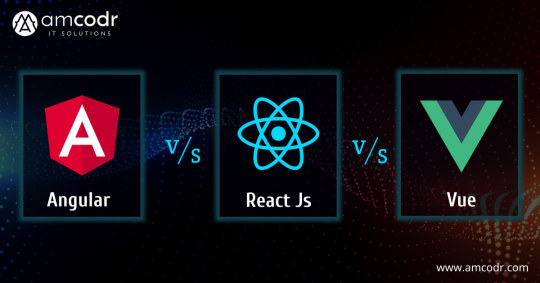
In 2024, the battle of JavaScript frameworks continues to be dominated by Angular vs. React vs. Vue, each bringing unique strengths to front-end development. Angular, backed by Google, remains a powerhouse with its comprehensive feature set and strong enterprise support. It excels in complex, large-scale applications requiring robust architecture and TypeScript integration.
React, maintained by Facebook, retains its popularity for its flexibility and virtual DOM efficiency, making it ideal for building interactive user interfaces. Its vast ecosystem and component-based structure empower developers to create scalable applications swiftly.
Meanwhile, Vue.js, known for its simplicity and ease of integration, has steadily gained ground with its progressive framework approach. It appeals to developers seeking a lightweight yet powerful solution for building modern UIs and single-page applications.
The decision between Angular, React, and Vue hinges primarily on the specific project demands, the proficiency of the team, and the scalability requirements. While Angular suits enterprise-grade applications, React’s flexibility caters well to diverse project scopes, and Vue’s simplicity attracts startups and small teams aiming for rapid development. In 2024, these three remain the cornerstone choices in the ever-evolving landscape of front-end development.
#Angular vs. React vs. Vue#reactjs#softwaredevelopmentcompany#appdevelopment#custom application development company
0 notes
Text
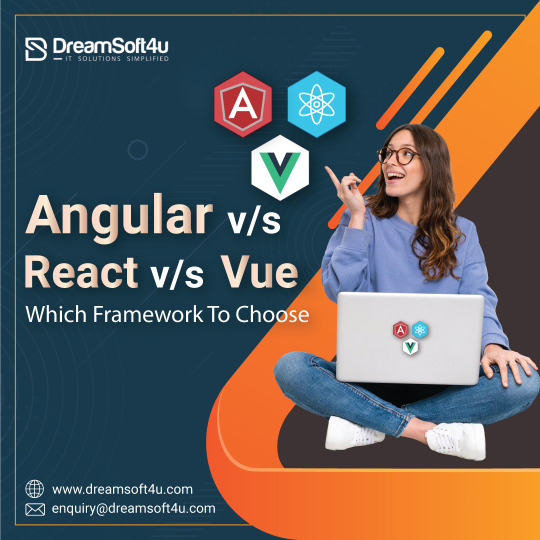
Angular is a TypeScript-based, open-source JavaScrip framework. Google maintains this framework. By using HTML and TypeScript, it builds a single-page application. React is a flexible, efficient, declarative JavaScript library that helps create user interfaces. It is an open-source front-end JavaScript library. It is a user interface library. Vue is an open-source model-view-ViewModel front-end JavaScript framework. It is used for developing single-page applications and user interfaces. The article will show the differences between Angular vs React vs Vue.
#angularjs development company#reactjs development company#reactjs development services#angularjs development services#vue vs react vs angular#vuejs development company#vuejs development services
0 notes
Text
0 notes
Text
Angular vs. Other Frameworks: Why It’s the Best Choice for Your Mobile App

In the modern digital age, developing mobile apps has become essential for driving business success. The competition in the mobile app market is intense, and picking the right framework can significantly impact your app’s performance, scalability, and overall success. Among the most popular frameworks are Angular, React, and Vue.js, but Angular mobile app development stands out for its comprehensive tools, advanced features, and support for complex projects. In this article, we’ll explore why Angular is the best choice for your mobile app development projects.
What is Angular?
Angular, an open-source front-end framework created by Google, was first introduced in 2010. Since then, it has evolved significantly, with Angular 2+ being a total overhaul of the original AngularJS. It’s written in TypeScript, offering developers a static type system that makes coding easier and less error-prone. With its component-based architecture and powerful development tools, Angular provides a robust environment for building dynamic, scalable, and secure mobile applications.
Importance of Frameworks in Mobile App Development
Frameworks are crucial in streamlining mobile app development tasks. They provide a structured foundation for building apps, reducing the need to write repetitive code and streamlining the development process. Frameworks like Angular, React, and Vue.js offer varying degrees of flexibility, ease of use, and performance optimization, making it critical to choose the right one based on the app’s requirements.
Angular vs. React
One of the most common comparisons in mobile app development is between Angular and React. React, developed by Facebook, is widely used for creating user interfaces, particularly single-page applications. Although both frameworks are highly capable, Angular offers a broader range of built-in functionalities, including modules for routing, forms, and HTTP communication. React, on the other hand, often requires third-party libraries to achieve the same functionality, which can increase the complexity of a project.
While React offers flexibility and a shorter learning curve, Angular’s opinionated architecture and robust tools make it a more suitable choice for large-scale and complex mobile app development projects.
Angular vs. Vue.js
Another widely used framework is Vue.js, appreciated for its straightforward approach and seamless integration. It’s often favored by small teams or individual developers for smaller applications. However, when it comes to handling more complex, enterprise-level applications, Angular takes the lead. Vue lacks some of the advanced features that Angular provides, such as dependency injection and comprehensive tooling, making it less suitable for large projects requiring scalability and maintainability.
Core Features of Angular for Mobile App Development
Component-Based Architecture: Angular’s component-based architecture enables developers to create reusable components, reducing redundancy and improving efficiency in development.
TypeScript Support: TypeScript, being a superset of JavaScript, introduces static typing and other advanced features, making debugging easier and code more reliable.
Two-Way Data Binding: This feature allows changes in the user interface to automatically update the underlying data model and vice versa, ensuring real-time synchronization.
Dependency Injection: Angular’s dependency injection system improves modularity and scalability, allowing components to be easily managed and tested in isolation.
Why Angular is Ideal for Complex Mobile App Projects
When managing a large-scale mobile app development project, Angular shines due to its modular development structure. By breaking the app into multiple modules, Angular makes it easier to manage, update, and scale complex applications over time. This is especially useful for projects that involve multiple teams working on different parts of the app, ensuring that changes in one module do not interfere with others.
Security in Angular
Security is a significant concern in mobile app development, and Angular provides several built-in features to enhance app security. It supports HTTPS communication and offers robust authentication mechanisms, including OAuth, JSON Web Tokens (JWT), and more. By incorporating these security protocols, Angular ensures that user data remains protected throughout the app’s lifecycle.
Performance Optimization with Angular
Angular’s Ahead-of-Time (AOT) compilation ensures that templates and components are pre-compiled, reducing the app’s initial load time. Additionally, Angular’s Change Detection feature minimizes unnecessary updates, optimizing the app’s performance, especially for large-scale projects.
Scalability of Angular for Growing Apps
One of Angular’s strongest attributes is its scalability. As mobile apps grow in complexity and usage, Angular’s modular architecture allows for easy updates and maintenance without disrupting the overall structure. Whether you’re building a small app or a massive enterprise solution, Angular can scale seamlessly to meet the app’s demands.
Support for Progressive Web Apps (PWAs)
Angular is also a popular choice for building Progressive Web Apps (PWAs), which offer users an app-like experience on the web. With PWA support, Angular enables developers to create fast, reliable, and engaging web experiences that work seamlessly across all devices.
Cross-Platform Development with Angular
Another significant advantage of Angular is its cross-platform development capabilities. Angular can be integrated with frameworks like Ionic to build hybrid mobile applications, providing a single codebase that works across multiple platforms, including iOS and Android.
Community and Ecosystem Support
Angular boasts one of the largest and most active developer communities in the tech world. With countless resources, tutorials, libraries, and tools available, developers can easily find solutions to common problems, making it easier to build and maintain Angular apps over the long term.
Conclusion
In conclusion, Angular stands out among other frameworks due to its robust set of features, scalability, and security. For mobile app development projects, particularly those that require handling complex functionalities and large datasets, Angular provides an ideal solution. Its modular architecture, cross-platform capabilities, and extensive community support make it the best choice for developing dynamic, scalable, and secure mobile applications.
FAQs
What sets Angular apart from other mobile app development frameworks? Angular’s component-based architecture, TypeScript support, and built-in security features make it ideal for large-scale mobile apps.
Is Angular suitable for small-scale mobile app projects? Yes, Angular can be used for small-scale apps, though its full potential is realized in complex, enterprise-level applications.
Can Angular be used for both web and mobile apps? Absolutely! Angular supports both web app development and cross-platform mobile app development through integration with tools like Ionic.
How secure is Angular for mobile app development? Angular offers strong security measures such as HTTPS for secure communication, various authentication mechanisms, and built-in safeguards to defend against common threats like XSS attacks.
Is Angular easy for new developers to learn? Angular has a steeper learning curve compared to frameworks like React or Vue.js, but its comprehensive documentation and community support make it accessible for new developers.
#Angular mobile app development#best mobile app frameworks#Angular vs React comparison#mobile app scalability#cross-platform app development#front-end frameworks for mobile#mobile app performance optimization#Angular app security#mobile app user experience#benefits of Angular for mobile#Angular vs Vue for mobile apps#mobile app development trends#Angular for enterprise apps#mobile app support frameworks#choosing the right mobile framework
0 notes
Text
A practical guide to selecting your web frontend framework
When starting a new web application project, choosing the preferred web frontend framework can often be a long and serious point of discussion. In this article, we hope to provide developers with a guide to selecting a suitable web frontend framework for different types of projects. JavaScript or TypeScript When we talk about frontend web development in the year 2023 and for probably the next…
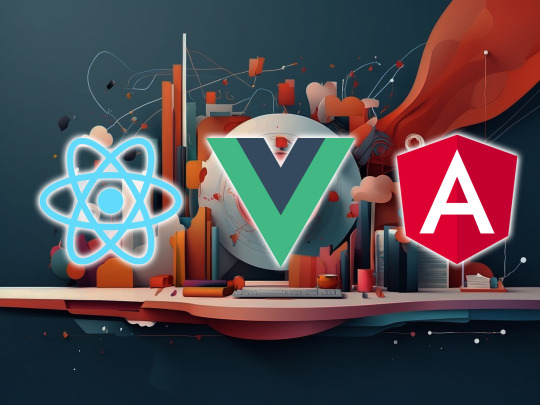
View On WordPress
#angular developer philippines#angular philippines#angularjs#frontend developer philippines#react philippines#react vs vue vs angular#reactjs#reactjs developer philippines#vue philippines#vuejs developer philippines#web design#web development#web programming
0 notes
Text
Trying to Decide Between Angular vs React vs Vue? Here’s What You Need to Know
We will give to the key reason to choose the right technology, we are going to offer you a comparison criterion by criterion so that you can weigh the pros and cons. depending on your profile, your situation, and your objectives, the solution will differ!
Whether you want to learn one of these tools or decide which framework to choose for our new project, you have come to the right place because, at the end of this article, you will have all the cards in hand to choose the most appropriate solution
Here, We Are Comparing These Frameworks Based On Different Criteria.
1. Comparing The History Of The Different Frameworks
2. Comparing The Sizes Of The Different Libraries
3. Comparing The Learning Curve Of The Different Frameworks
4. Comparing The Productivity And Maintainability Of The Different Frameworks
5. Comparing The Scalability Of The Different Frameworks
Finally, each technology has a unique set of advantages and disadvantages. This article will help you through all the information about the Decide Between Angular vs React vs Vue. Here’s What You Need to Know.
0 notes
Text
Best Framework For Front-End Development In 2023

In 2023, among all the platforms based on JS, we can distinguish the three most popular ones for front-end development: Angular, React and Vue.
What are Angular, React and Vue?
Angular (also known as Angular 2.0) is a development framework released by Google in 2016. The first version of the framework is called AngularJS, but it has several fundamental differences compared to later versions. For example, AngularJS uses only JavaScript, while its successor supports JS and TypeScript.
React is a JavaScript library developed by Facebook in 2013. The developers included several innovations in the tool that made it possible to simplify the development process. For example, they were among the first to use a component-oriented architecture, that is, the division of a project into logical and functional components. The community liked this architecture so much that Google developers added it to Angular2.
Vue is a progressive front-end framework created by a former Google employee as a lighter alternative to Angular.
Similarities and differences
First, let's deal with the main purpose of these development environments. React is a library, meaning it only provides UI components. This gives more flexibility, but additional functions will require the connection of third-party modules and tools.
Angular is a complete framework. That is, "out of the box" gives the complete architecture of the application, and also includes some tiny libraries to perform specific tasks. But this is not always a plus: some of the modules will hang unused and create an unnecessary load.
Vue.js is a progressive framework for developing user interfaces and single-page web applications in JavaScript. It solves the tasks of the presentation layer (view) and simplifies the work with libraries. Vue.js can be implemented incrementally, which makes it different from other frameworks.
To learn more about Angular, Vue and React, study our article dedicated to these frameworks: https://neklo.com/angular-react-vue/
1 note
·
View note
Text
Introduction to GraphQL for Full Stack Applications
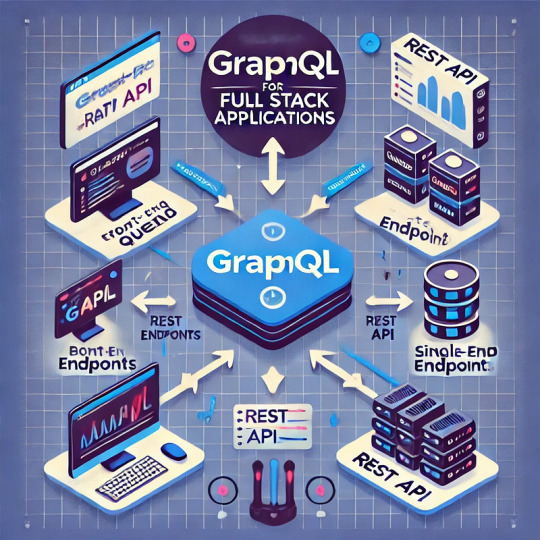
What is GraphQL?
GraphQL is a query language for APIs and a runtime for executing those queries by leveraging a type system defined for the data. Developed by Facebook in 2012 and open-sourced in 2015, GraphQL provides a flexible and efficient alternative to REST APIs by allowing clients to request exactly the data they need — nothing more, nothing less.
Why Use GraphQL for Full Stack Applications?
Traditional REST APIs often come with challenges such as over-fetching, under-fetching, and versioning complexities. GraphQL solves these issues by offering:
Flexible Queries: Clients can specify exactly what data they need.
Single Endpoint: Unlike REST, which may require multiple endpoints, GraphQL exposes a single endpoint for all queries.
Strongly Typed Schema: Ensures clear data structure and validation.
Efficient Data Fetching: Reduces network overhead by retrieving only necessary fields.
Easier API Evolution: No need for versioning — new fields can be added without breaking existing queries.
GraphQL vs. REST: Key Differences
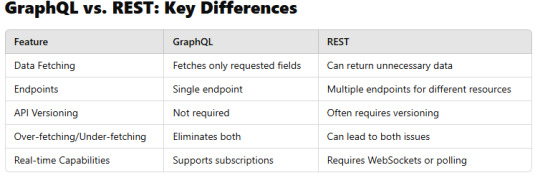
Core Concepts of GraphQL
1. Schema & Types
GraphQL APIs are built on schemas that define the data structure.
Example schema:graphqltype User { id: ID! name: String! email: String! }type Query { getUser(id: ID!): User }
2. Queries
Clients use queries to request specific data.graphqlquery { getUser(id: "123") { name email } }
3. Mutations
Used to modify data (Create, Update, Delete).graphqlmutation { createUser(name: "John Doe", email: "[email protected]") { id name } }
4. Subscriptions
Enable real-time updates using Web Sockets.graphqlsubscription { newUser { id name } }
Setting Up GraphQL in a Full Stack Application
Backend: Implementing GraphQL with Node.js and Express
GraphQL servers can be built using Apollo Server, Express-GraphQL, or other libraries.
Example setup with Apollo Server:javascriptimport { ApolloServer, gql } from "apollo-server"; const typeDefs = gql` type Query { hello: String } `;const resolvers = { Query: { hello: () => "Hello, GraphQL!", }, };const server = new ApolloServer({ typeDefs, resolvers });server.listen().then(({ url }) => { console.log(`Server running at ${url}`); });
Frontend: Querying GraphQL with React and Apollo Client
Example React component using Apollo Client:javascriptimport { useQuery, gql } from "@apollo/client";const GET_USER = gql` query { getUser(id: "123") { name email } } `;function User() { const { loading, error, data } = useQuery(GET_USER); if (loading) return <p>Loading...</p>; if (error) return <p>Error: {error.message}</p>; return <div>{data.getUser.name} - {data.getUser.email}</div>; }
GraphQL Best Practices for Full Stack Development
Use Batching and Caching: Tools like Apollo Client optimize performance.
Secure the API: Implement authentication and authorization.
Optimize Resolvers: Use DataLoader to prevent N+1 query problems.
Enable Rate Limiting: Prevent abuse and excessive API calls.
Conclusion
GraphQL provides a powerful and efficient way to manage data fetching in full-stack applications. By using GraphQL, developers can optimize API performance, reduce unnecessary data transfer, and create a more flexible architecture.
Whether you’re working with React, Angular, Vue, or any backend framework, GraphQL offers a modern alternative to traditional REST APIs.
WEBSITE: https://www.ficusoft.in/full-stack-developer-course-in-chennai/
0 notes
Text
React JS vs Other Frameworks: Which Is Best?

Why React JS Stands Out
Before we get into the details about the differences, let’s look at the reasons behind why web development using React JS is such an incredibly popular choice. React is a product created by Facebook and is well-known for its modular architecture that is flexible, flexible, and efficient. It lets developers build reused UI components, which makes development easier and more manageable.
Key Features of React JS
Component-Based Architecture helps to break down complicated UI into smaller pieces that can be reused.
VirtualDOM — Increases the speed of web pages by only updating necessary portions of the website.
Solid Community Support — Many developers contribute to the improvement of React everyday.
SEO-friendly When properly executed rendering on the server side, React can be optimized for search engines.
React JS vs Angular
Angular is a framework created by Google and is a different powerhouse in front-end development. In contrast to React which is a program, Angular is a fully-fledged framework. React can be more flexible, and permits developers to select the tools they prefer, while Angular has a well-defined and highly opinionated method. The learning curve is more than React, which makes it more difficult for newcomers to master.
In terms of performance, React tends to be more efficient because of the Virtual DOM implementation, which eliminates unnecessary rendering re-runs. However Angular’s actual DOM manipulations can cause performance bottlenecks when using complex applications. If you’re looking for an all-in-one solution that includes an inbuilt routing and management of state, Angular might be a more suitable choice. If you prefer the flexibility, web development React JS is an excellent choice.
React JS vs Vue.js
Vue.js is frequently regarded as an intermediate between React as well as Angular. It is well-known for its user-friendliness and its gradual adoption. When compared with React, Vue has a more streamlined learning curve, which makes it an ideal choice for people who are new to the game.
Although the two React and Vue provide high-performance, the vast community support and its extensive ecosystem give an advantage when it comes to large-scale applications. Vue’s reactivity mechanism allows data binding to be simple however React demands explicit management of states. In the case of a small project that requires a simpler system to incorporate, Vue could be the best option. But for longer-term scalability and widespread adoption, React JS web development remains the most robust choice.
So, Which One is Best for You?
There isn’t a universal answer to this question. It depends on the specifics of your needs for your project:
Use React JS If you’re looking for a flexible system and performance that is high. an extensive community.
Choose an Angular If you’re looking for an all-in-one, structured solution.
Choose Vue.js if you’re looking for something easy-to-learn with low learning curve.
As a programmer, I personally enjoy web development with React JS due to its speed, flexibility, and the strong community support. If you’re committed to front-end development, getting familiar with React will open many possibilities.
Which one do you prefer? Tell me your thoughts by leaving a comment!
0 notes
Text
write for us + software
Are you passionate about write for us + software, software development, programming, or technology? Do you have valuable insights, tutorials, or industry knowledge to share? If so, we invite you to contribute to our platform and become a guest writer!
Why Write for Us?
By contributing to our website, you will: ✅ Gain exposure to a broad tech audience. ✅ Boost your credibility as a software expert. ✅ Earn valuable backlinks to your website or portfolio. ✅ Help developers & tech enthusiasts by sharing your expertise.
Topics We Accept
We welcome high-quality, well-researched, and original articles on:
1. Software Development & Engineering
Best practices in software development.
Coding tips, tricks, and hacks.
Agile, Scrum, and software project management.
2. Programming Languages & Frameworks
Python, Java, JavaScript, C++, and more.
Web development (React, Angular, Vue).
Backend technologies (Node.js, Django, Laravel).
3. Software Testing & QA
Automated testing tools and techniques.
Manual vs. automated testing strategies.
4. AI, Machine Learning & Data Science
AI applications in software.
Data science trends and insights.
5. Cybersecurity & Software Security
Best practices for secure coding.
Protecting software from cyber threats.
6. Software Tools & SaaS Applications
Reviews of software tools and platforms.
Comparisons of SaaS solutions.
7. Cloud Computing & DevOps
AWS, Google Cloud, and Microsoft Azure.
CI/CD, containerization (Docker, Kubernetes).
Submission Guidelines
To ensure quality, please follow these rules: ✅ Original Content – No plagiarism, AI-generated, or republished content. ✅ Word Count – Minimum 1,500 words per article. ✅ Well-Structured – Use proper headings (H1, H2, H3). ✅ SEO Optimized – Include relevant keywords naturally. ✅ Engaging & Informative – Provide real value to readers. ✅ Relevant Images – Add screenshots, infographics, or code snippets.
How to Submit Your Article?
1️⃣ Email us at [Your Email] with the subject “Guest Post Submission – Software”. 2️⃣ Attach your article in Google Doc or Word format. 3️⃣ Include a short author bio (50-100 words) with your website or social links.
What Happens Next?
✔️ Our editorial team reviews submissions within 7 business days. ✔️ If approved, your article will be published with full credit. ✔️ You’ll receive a confirmation email with the live article link.
Join Our Tech Community!
Don’t miss this opportunity to showcase your expertise and contribute to the software development world.
📧 Ready to submit? Send your article to [[email protected]] today!
We look forward to featuring your insights on our platform! 🚀
1 note
·
View note
Text
AngularJS vs ReactJS vs VueJS: Choosing the Right Framework for Your Business

Are you facing the tough task of choosing the perfect front-end technology for your business? Thinking which framework will best suit your needs and move your projects toward success?
Look no further! In this entire blog, we aim to answer the hot question: AngularJS vs ReactJS vs VueJS – Which is best for your business?
As a Vue.js development company, we understand the importance of choosing the right structure to build best and high-performance applications. Let’s explore the power, weaknesses, and best use cases of these top structures.
The Evolution of Frontend Development
Frontend development has seen fast evolution, with an arrangement of frameworks complete for attention. Choosing the right framework can be amazing, but we’re here to explaining the selection process and provide valuable understanding.
Whether you are a start-up building a dynamic web application, an enterprise seeking flexibility, or a developer aiming to stay updated, this guide is for you. We explore the strengths, weaknesses, and ideal use cases of AngularJS, React, and Vue.js.
Understanding AngularJS
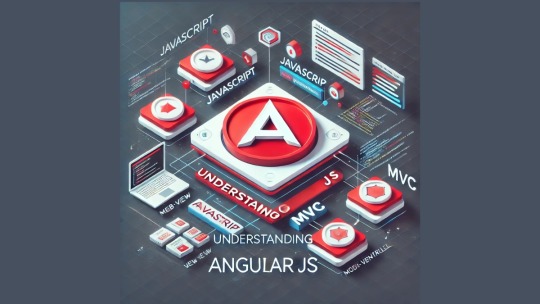
AngularJS, developed by Google, restructures frontend development with features like two-way data binding and dependency dose. However, with the release of Angular 2+, AngularJS has taken a minor step.
Strengths of AngularJS
Comprehensive Framework – Offers tools for routing, form validation, and testing.
TypeScript Integration – Enhances code organization and maintainability.
Enhanced Performance – Optimized with Ahead-of-Time (AOT) compilation.
Component-Based Architecture – Promotes modular development.
Strong Community Support – Backed by Google and widely used in enterprises.
Weaknesses of AngularJS
Performance Limitations – Two-way data binding can slow down highly dynamic applications.
Steeper Learning Curve – Complex architecture makes it harder to master.
Understanding ReactJS
React, developed by Facebook, is widely adopted for its component-based architecture and efficient rendering.
Strengths of ReactJS
Component-Based Architecture – Encourages reusability and maintainability.
Virtual DOM – Ensures efficient UI updates and improved performance.
Unidirectional Data Flow – Simplifies debugging and state management.
JSX Syntax – Allows seamless integration of UI and logic.
Strong Ecosystem – Large community and numerous third-party libraries.
React Native – Enables cross-platform mobile development.
Weaknesses of ReactJS
Boilerplate Code – Requires additional setup for state management (e.g., Redux).
Learning Curve – Concepts like JSX and component lifecycle need initial effort.
Understanding Vue.js
Vue.js, known as the progressive JavaScript framework, is gaining popularity due to its simplicity and flexibility.
Strengths of Vue.js
Easy to Learn – Simple syntax and minimal setup make it beginner-friendly.
Component-Based Architecture – Encourages modular design.
Reactive Data Binding – Ensures efficient and automatic UI updates.
Vue CLI & DevTools – Enhances developer experience with streamlined workflows.
Flexibility & Scalability – Suitable for small and large applications.
Vue Router & Vuex – Official solutions for routing and state management.
Weaknesses of Vue.js
Smaller Ecosystem – Fewer third-party libraries compared to React and Angular.
Maturity Concerns – Lesser enterprise adoption compared to its competitors.
Choosing the Best Framework for Your Business
Selecting the right framework depends on multiple factors:
Project Complexity – Angular suits large-scale applications, React and Vue.js work well for diverse projects.
Learning Curve – Vue.js is the easiest to learn, followed by React, while Angular has the steepest curve.
Community Support – React has the largest community, followed by Angular and Vue.js.
Performance Needs – React and Vue.js offer better performance for dynamic applications.
Conclusion
AngularJS, ReactJS, and Vue.js each have their strengths and use cases. AngularJS is robust but has a steeper learning curve, React is widely adopted for its flexibility, and Vue.js stands out for its simplicity.
Evaluate your project’s needs carefully to choose the best framework for your business’s success.IMENSO Software honored that our expertise has been recognized by platforms like GoodFirms, Clutch, and MirrorView. Need expert guidance? Contact a Vue.js development company to bring your project to life!
0 notes
Text
Mobile app development can be costly, much more than a functional website. And as mobile technologies are evolving, experts are trying to figure out ways to reduce this cost. Cross-platform application frameworks are a step towards this motive. Before the introduction of these, businesses had to make different versions of mobile app. A version each for iOS and Android. Hiring experts of two different technologies can be too costly. And not to mention the maintenance cost of each app. React Native and Ionic are two of the popular cross-platform app development platforms going around. In 2020, React native was the most popular mobile app framework used by developers. Ionics was fourth on the list. However, as the two platforms are being continuously improved, the race is still on. Ionics vs React Native has become a hot debate in the developers' community. In this article, I’m going to compare the two in different aspects. I’m not going to be biased, nor am I going to reach a final verdict. The final decision will be yours. So, let's get started! 1. Functionalities React Native and Ionic are two different frameworks, thus they have different functionalities. One has to be proficient in JavaScript as React native apps are developed using JS. The code communicates with the platform, be it iOS or Android, and relays necessary data calls and functions to the native platform API. There’s a JavaScript API that connects with the native platform API via a bridge. This bridge is the reason why React native apps work like native apps. On the other hand, Ionic is based on Cordova that uses a Webview component (UIWebView on iOS and WebView on Android) or a chromeless browser view. The WebView components use an HTML layout engine to render HTML/CSS user interface. Cordova relies on a Javascript-native bridge to ensure communication between the WebView application and the Native platform. This way, the framework can access Native APIs and device features like the camera. 2. Technology Stack As said before, React Native is written in the JavaScript framework. Instead of HTML, the UI pieces are written in JSX. JSX incorporates all the powers of JavaScript and is much more advanced than any other language template. React Native uses both React because both frameworks are open-sourced and products of the same company, Facebook. If we talk about the technology stack of Ionic, you can use Angular, Vue, or even React to build Ionic apps. That makes it a little more flexible than React Native. The latest release of Ionic 4 allows you to use Ionic even with any web development framework. In this regard, developers might consider Ionic a better option -- especially after the recent update. It has opened up a huge amount of flexibility in building Ionic apps. Even web developers can learn and use this framework to develop Ionic apps. 3. Learning Curve The learning curve of different technologies varies greatly. Most people find React Native easy to learn and get started with it in little time. The concepts and way of coding are pretty much the same in React. If you know a bit about React and React Native, you must be aware of the small differences. For example, react has web components like , , while React Native has components that are wrappers around native iOS and Android components. However, if we talk about people who don’t know React, they will have to learn JavaScript and React first. And the learning curve can be quite steep with no React knowledge. On the other hand, Ionic’s tech is flexible. While implementing this framework, developers use JavaScript, CSS, and HTML along with their chosen web framework. It could be Angular, React, Knockout, Vue, or any other compatible framework. So, the learning curve here isn’t as steep as it can be in the case of React Native if you have no knowledge of React. 4. Performance Well, I’ll be honest here. Native apps are great if you are someone keen to give a top-notch performance to your users.
The comparison is between Ionic and React Native, not native apps vs either of them as native apps always exceed the other two. React Native is closer to native apps in terms of performance. And a little ahead of Ionic. React Native uses JavaScript to build native apps, so it has the same look and feel like a native app, and even uses the same building blocks that native apps use. On the other hand, Ionic is a hybrid approach. It doesn’t build native apps and you can encounter performance issues as there are lots of callbacks to the native code. This can also cause a lag. Also, you have to use the Cordova plugin if you want to access native features. One has to deal with performance issues while building UIs. So, if we sum this up, React Native is quite better in terms of performance. 5. Developer Community Community is something we all consider when choosing a certain technology to learn. The more people are involved in it, the faster it grows with time. GitHub stats indicate strong community involvement in both technologies. React Native has over 1900 contributors to the framework, while Ionic has around 330 contributors to the framework. React Native has 78k stars while Ionic has 38k stars. Hence, in terms of community, React Native is far ahead of ionic. But with the recent updates, we can expect Ionic to have greater community involvement in the coming months. P.S. Whatever framework you prefer, we love both! We are a Mobile App Development Company in Dubai with a strong clientele base all across UAE. For the design and development of any kind of app, we’re ready to help. Get in touch for more details.
0 notes
Text
🌟 JavaScript Frameworks Showdown: React vs. Angular vs. Vue.js 🌟
Hey, web devs! 👩💻👨💻 Ready to dive into the world of JavaScript frameworks? Let’s break down the big three: React, Angular, and Vue.js! 🚀
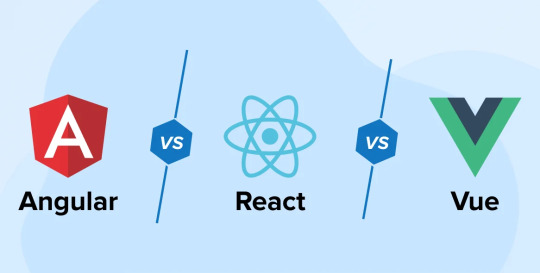
🔍 Quick Overview
React: Created by Facebook, this library is all about building awesome user interfaces with reusable components. It uses a Virtual DOM for super-fast performance! ⚡️
Angular: Developed by Google, Angular is a full-fledged framework perfect for large applications. It features two-way data binding and comes packed with tools! 🛠️
Vue.js: The rising star! 🌟 Vue is flexible and easy to learn, making it great for both newbies and pros. It’s all about reactive data binding!
💪 Strengths & Weaknesses
Feature React Angular Vue.js Architecture Component-Based MVC Component-Based Data Binding Unidirectional Two-Way Reactive Performance Virtual DOM Optimized but complex Super Fast Learning Curve Moderate Steep Easy Community Support Strong Strong Growing
🤔 Which One to Choose?
React: Perfect for high-performance apps with complex UIs!
Angular: Ideal for big projects needing a comprehensive solution!
Vue.js: Great for small to medium projects or when you want something easy to pick up!
💡 Final Thoughts
Each framework has its vibe! Whether you’re building a sleek app or diving into enterprise solutions, there’s a perfect fit for you. 🌈✨
For expert guidance in your development journey, check out Hexadecimal Software and explore innovative solutions at HexaHome!
Happy coding! 🎉💻
0 notes
Text
Angular vs React vs Vue: Which One is The Best
Choosing the right front-end framework is crucial for web development. React, Angular, and Vue are the top contenders, each with unique strengths. Dive into our latest blog to explore their features, pros, and cons to help you make the best decision for your next project.
#ReactJSDevelopmentServices#VuejsDevelopment#Angular#React#Vue#WebDevelopment#JavaScriptFrameworks#DisciplineInfotech
0 notes
Text
World of Web Development: Full-Stack vs. Front-End and Back-End Roles in 2024
As technology continues to advance, understanding the nuances between various web development roles is crucial for both budding developers and businesses looking to hire talent. For those looking to master the art of Full Stack, enrolling in a reputable Full Stack Developer Training in Pune can provide the essential skills and knowledge needed for navigating this dynamic landscape effectively.
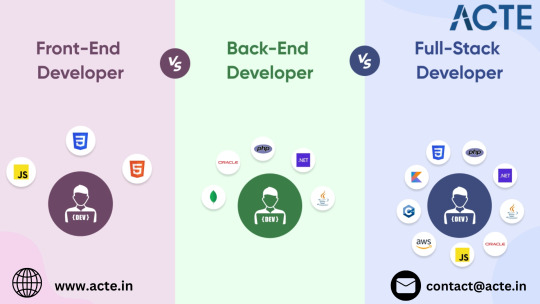
In 2024, the landscape of web development is more diverse than ever, with distinct roles such as full-stack, front-end, and back-end developers playing pivotal parts in creating robust web applications. This blog delves into the key differences between these roles, their specific responsibilities, and the skill sets required.
Defining Full-Stack Development
Full-stack development involves a comprehensive approach to web development, where a developer is proficient in both the front-end and back-end aspects of a project. Full-stack developers have a broad skill set that allows them to handle every phase of web development, ensuring that all components of an application work seamlessly together.
Key Duties:
Front-End Responsibilities: Designing and implementing user interfaces with technologies like HTML, CSS, and JavaScript, along with frameworks such as React or Angular.
Back-End Responsibilities: Managing server-side operations, database interactions, and application logic using tools like Node.js, Django, or Ruby on Rails.
End-to-End Integration: Ensuring cohesive functionality between the user interface and server-side systems.
Exploring Front-End Development
Front-end development is focused on the client side, where developers create the visual and interactive aspects of a web application. This role emphasizes crafting engaging user experiences and ensuring that the interface is both aesthetically pleasing and functional.
Key Duties:
User Interface Design: Building and styling the elements users interact with using HTML, CSS, and JavaScript.
User Experience Optimization: Enhancing the usability and accessibility of the application to provide a seamless user experience.
Technology Stack: Utilizing front-end frameworks like React, Angular, or Vue to develop responsive and dynamic web pages. Here’s where getting certified with the Top Full Stack Online Certification can help a lot.
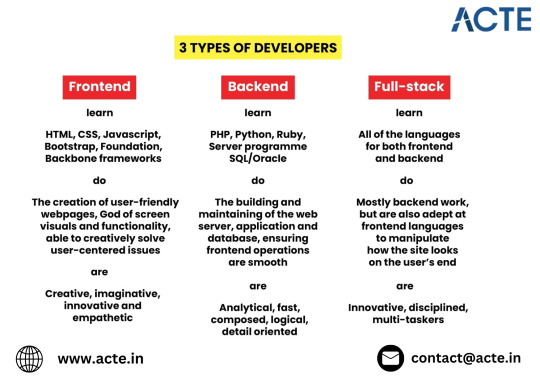
Understanding Back-End Development
Back-end development deals with the server side of web applications. Back-end developers focus on the application's functionality, handling data management, server logic, and ensuring that user requests are processed correctly.
Key Duties:
Server Logic Implementation: Writing code that processes business logic and manages server operations.
Database Management: Designing and maintaining databases using SQL or NoSQL technologies to store and retrieve data efficiently.
API Creation: Developing and managing APIs that facilitate communication between the front-end and back-end.
Comparing the Roles
Scope and Responsibilities:
Full-Stack Developers: Possess a holistic skill set that covers both front-end and back-end development, providing a unified approach to project development and integration.
Front-End Developers: Specialize in crafting the visual elements of web applications, focusing on design and user interaction without engaging in server-side coding.
Back-End Developers: Concentrate on the server-side aspects, including application logic and data management, while collaborating with front-end developers to ensure proper integration.
Skill Sets Required:
Full-Stack Developers: Must be versatile, with proficiency in both client-side and server-side technologies, and an ability to integrate these elements effectively.
Front-End Developers: Require expertise in design principles, user interface development, and client-side programming languages.
Back-End Developers: Need strong skills in server-side programming, database management, and API development.
Flexibility and Collaboration:
Full-Stack Developers: Offer broad capabilities, enabling them to handle multiple aspects of development and ensuring smooth integration between different parts of an application.
Front-End Developers: Work closely with back-end teams to ensure that the visual interface aligns with server-side logic and data processing.
Back-End Developers: Collaborate with front-end developers to make sure the server-side functions are properly reflected in the user interface.
Conclusion
In the evolving tech landscape of 2024, understanding the distinct roles of full-stack, front-end, and back-end developers is essential. Each role brings unique skills and responsibilities to the table, contributing to the successful creation and maintenance of web applications. Whether you are embarking on a career in web development or looking to hire the right professionals, grasping these differences will help you make informed decisions and build successful digital solutions.
#full stack course#full stack developer#full stack software developer#full stack training#full stack web development
0 notes
Text
Selenium vs. Cypress: Choosing the Right Tool for Your Web Testing
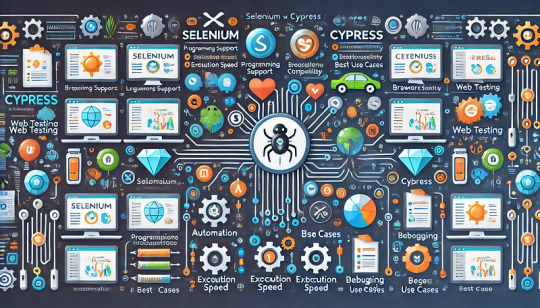
Selenium vs. Cypress:
Choosing the Right Tool for Your Web Testing Automated testing is a crucial part of modern web development, ensuring that applications function correctly across different environments. Selenium and Cypress are two of the most popular tools for web testing, but they have distinct differences that make them suitable for different use cases.
Introduction to Selenium and Cypress Selenium
✅ What is it? Selenium is an open-source testing framework that allows automation of web applications across multiple browsers. It supports various programming languages such as Java, Python, JavaScript, and C#.
✅ Key Features:
Supports multiple browsers (Chrome, Firefox, Edge, Safari, etc.) Allows testing across different operating systems Integrates with various testing frameworks (JUnit, TestNG, etc.) Supports parallel execution and remote testing with Selenium Grid
✅ Best For: Cross-browser testing Large-scale enterprise applications Teams working with multiple programming languages Cypress
✅ What is it? Cypress is a modern, JavaScript-based testing framework built for end-to-end testing of web applications.
Unlike Selenium, it runs directly in the browser, providing fast execution and real-time debugging.
✅ Key Features:
Fast execution with automatic waiting Built-in debugging and time-travel feature Works only with JavaScript and Node.js Supports headless execution Provides native support for modern JavaScript frameworks like React, Angular, and Vue
✅ Best For: Single-page applications (SPAs) JavaScript-heavy applications Developers looking for an easy-to-setup tool with real-time debugging
3. When to Choose Selenium?
🔹 You need cross-browser testing: Selenium supports multiple browsers, including Safari and Edge, making it a better choice for testing across different environments.
🔹 You work with multiple programming languages: Selenium allows test scripts in Java, Python, C#, and more, making it flexible for teams with diverse expertise.
🔹 You are testing legacy applications: If your web application uses older technologies, Selenium provides better support compared to Cypress.
🔹 You require mobile automation: Selenium works with Appium for mobile application testing, whereas Cypress is strictly for web applications.
🔹 You need cloud-based execution: Selenium integrates with cloud testing platforms like BrowserStack and Sauce Labs for remote execution.
4. When to Choose Cypress?
🔹 You need fast execution and real-time debugging:
Cypress runs inside the browser, making it significantly faster and easier to debug with its time-travel feature.
🔹 You are testing modern web applications: Cypress is optimized for single-page applications (SPAs) and JavaScript frameworks like React, Angular, and Vue.
🔹 You prefer an easy setup and better developer experience: Cypress has built-in commands and automatic waiting, reducing flaky tests and making test writing simpler.
🔹 You are working in a JavaScript/Node.js environment:
If your team primarily uses JavaScript, Cypress is the best choice due to its native support.
🔹 You want an all-in-one testing solution:
Cypress provides built-in features like mocking, assertions, and network request handling without needing additional libraries.
Conclusion:
Which One Should You Choose? Use Selenium if you need cross-browser testing, language flexibility, mobile automation, and large-scale enterprise testing. Use Cypress if you need faster execution, modern web app testing, real-time debugging, and an easy setup.
Final Thought:
If your application relies on JavaScript-heavy front-end frameworks, Cypress is the better option. However, if cross-browser compatibility and large-scale testing are your priorities, Selenium is the more versatile choice.
WEBSITE: https://www.ficusoft.in/software-testing-course-in-chennai/
0 notes